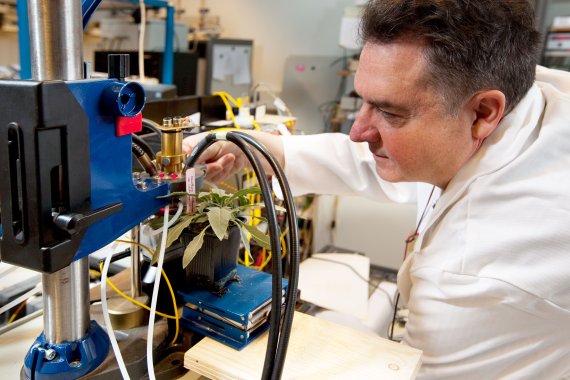According to a publication in Science, researchers from the University of Illinois have repaired a glitch in the photosynthesis of plants. Plants produce an enzyme called Rubisco that helps convert CO2 from the air into sugars for the plant. Except that 20 per cent of the time the enzyme takes oxygen from the air by mistake instead of CO2. That leads to toxic compounds that the plant then has to get rid of, leaving it with less energy for growth. The Americans disabled the gene that is normally responsible for disposing of the toxic compound in the tobacco plant and added alternative breakdown genes from an alga and a pumpkin. The resulting genetically modified tobacco plant produced 40 per cent more biomass.
75 per cent more
‘That is an incredibly significant result,’ says Klein Lankhorst, who coordinated the large photosynthesis programme BioSolar Cells for WUR. ‘We have been saying for years that photosynthesis could be improved substantially. The American researchers have now shown what is possible.’ It is not the first breakthrough in the field of photosynthesis. Other researchers had already managed to improve photosynthesis by 15 to 20 per cent using different techniques. Klein Lankhorst: ‘Different processes were involved each time but if you could apply them in combination, you might potentially get plants that produce 75 per cent more biomass.’
That does not necessarily mean you will have better food production though, explains Klein Lankhorst. ‘You don’t want metre-high potato plants; you want plants with bigger tubers. The question is how you can turn the increase in photosynthesis into greater specific yields.’
CRISPR-CasAnother issue is that the Americans created a genetically modified organism (GMO). ‘In Wageningen, we are looking for the natural variation in plants, for example genes in desert plants that have an exceptionally high capacity for photosynthesis. Then you don’t need transgenes. Although I do think we will need CRISPR-Cas to improve the photosynthesis with species-specific genes, otherwise the breeding process will take much too long.’
Klein Lankhorst has been lobbying the European Commission in Brussels for years for a big research programme aimed at improving food production by increasing the yield per plant. ‘We are facing the challenge of producing more food for a growing world population while at the same time achieving climate targets and using water and minerals more efficiently. You need better photosynthesis for that.’
Public opinion
Klein Lankhorst is currently coordinating the European project CropBooster-P, which is assessing how we can achieve this increase in yields over the next 10 years. In additional to technical research, we also need society’s opinion, says Klein Lankhorst. That is why social scientists will be presenting the CropBooster-P scenarios to panels of consumer organizations, farmers and industry players over the next few years. Consumer scientists will also be engaging in a dialogue with a citizens’ jury. ‘The idea is that you grab people off the street, ask them to spend two days in a hotel, give them information about the scenarios and let them come up with a shared opinion.’ Klein Lankhorst hopes that will result in an unambiguous proposal that the researchers can submit to the European Commission. The EU will then have to decide whether it wants to invest in food crops with improved photosynthesis.
The EU has invested three million euros in CropBooster-P, a project in which WUR is collaborating with such leading research organizations as INRA in France, VIB in Belgium, the University of Nottingham in the UK and the European organization EPSO.

 Jeremy Harbinson performs photosynthesis-research in Wageningen. Photo: G.J.Vlekke
Jeremy Harbinson performs photosynthesis-research in Wageningen. Photo: G.J.Vlekke